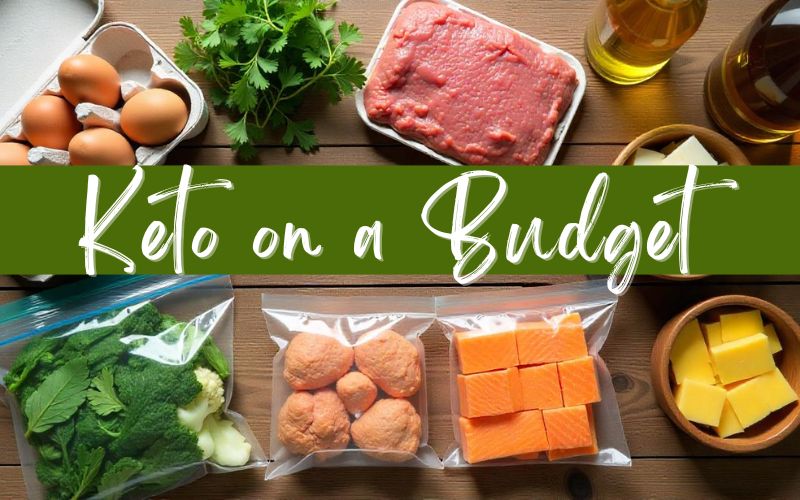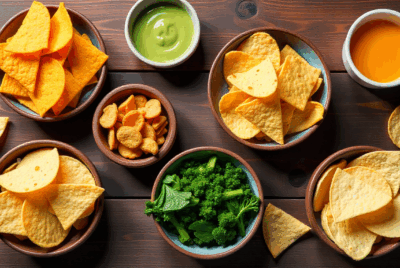Keto on a Budget: Tips for Affordable Eating
Eating healthy doesn’t have to drain your wallet. If you’re thinking about starting the keto diet but worried about the cost, you’re not alone. Many assume keto means pricey specialty foods, expensive cuts of meat, and endless supplements. The good news? You can enjoy all the benefits of the keto diet—without breaking the bank. Here’s how.
Why Keto Can Seem Expensive
Let’s be real—store-bought keto products like protein bars, almond flour, or pre-packaged meals can be pricey. And if you’re new to keto, it’s easy to get caught up in the marketing hype.
But keto is rooted in whole, real foods—and that can actually save you money. The trick is knowing where to spend, how to shop, and what to skip.
Budget-Friendly Keto Staples to Keep on Hand
Here are nutrient-dense, affordable keto items that form the foundation of a low-carb, high-fat lifestyle:
- Eggs – Inexpensive, versatile, and a perfect source of protein and healthy fat.
- Ground beef or chicken thighs – Cheaper than premium cuts, high in fat and flavor.
- Frozen vegetables – Often more affordable than fresh and just as nutritious.
- Canned tuna or salmon – Great for quick meals and loaded with protein.
- Cheese – A keto staple that’s budget-friendly when bought in blocks.
- Butter and olive oil – Long-lasting fats that can be used across many meals.
Tips for Affordable Keto Eating
1. Plan Your Meals: Meal planning is one of the most effective ways to save money on the keto diet. By planning your meals for the week, you can make a precise shopping list and avoid impulse purchases.
How to Plan Your Meals:
- Create a Weekly Menu: Decide on your meals and keto snacks for the week.
- Make a Shopping List: List all the ingredients you need to avoid buying unnecessary items.
- Prep in Advance: Spend a few hours prepping ingredients or cooking meals for the week to save time and reduce food waste.
2. Buy in Bulk: Buying in bulk can significantly reduce the cost per unit of many keto staples. Look for bulk deals on items like meat, nuts, seeds, and oils.
Tips for Bulk Buying:
- Join a Wholesale Club: Memberships at stores like Costco or Sam’s Club can provide substantial savings.
- Look for Sales: Stock up on bulk items when they go on sale.
- Store Properly: Freeze meats and store bulk items in airtight containers to maintain freshness.
3. Choose Budget-Friendly Proteins: Protein can be one of the more expensive components of the keto diet, but there are plenty of affordable options.
Affordable Protein Sources:
- Eggs: A versatile and inexpensive source of high-quality protein.
- Chicken Thighs and Drumsticks: Cheaper cuts of chicken that are still keto-friendly.
- Ground Meat: Ground beef, pork, or turkey can be more affordable than whole cuts.
- Canned Fish: Tuna, salmon, and sardines are budget-friendly and packed with nutrients.
4. Embrace Frozen and Canned Vegetables: Fresh produce can be expensive, especially out of season. Frozen and canned vegetables are cost-effective alternatives that retain most of their nutritional value.
Tips for Using Frozen and Canned Vegetables:
- Choose Low-Carb Options: Look for vegetables like broccoli, spinach, cauliflower, and green beans.
- Check Labels: Ensure there are no added sugars or preservatives in canned vegetables.
- Use in Recipes: Incorporate these vegetables into soups, stews, and casseroles.
5. Make Use of Affordable Fats: Healthy fats are a cornerstone of the keto diet. Fortunately, many keto-friendly fats are affordable.
Affordable Fat Sources:
- Butter and Ghee: Widely available and cost-effective.
- Olive Oil: A versatile cooking oil that’s often available at a reasonable price.
- Coconut Oil: A multi-use oil that can be bought in bulk for savings.
- Avocados: While they can be pricey, look for sales or buy in bulk when prices drop.
6. Cook at Home: Eating out can be costly and challenging for keto adherence. Cooking at home allows you to control ingredients and portions, saving money and ensuring your meals are keto-friendly.
Cooking at Home Tips:
- Batch Cooking: Prepare large quantities of food at once and store portions for later.
- Simple Recipes: Focus on simple, one-pan meals that require minimal ingredients and effort.
- Use Leftovers: Repurpose leftovers into new meals to reduce waste and save money.
7. Shop Smart: Smart shopping strategies can help you find the best deals and stretch your food budget further.
Smart Shopping Tips:
- Compare Prices: Check prices at different stores or online to find the best deals.
- Use Coupons and Apps: Take advantage of coupons, discount apps, and loyalty programs to save money.
- Shop Seasonal: Buy produce that’s in season for better prices and quality.
- Avoid Convenience Foods: Pre-packaged keto snacks and meals can be expensive. Make your own to save money.
8. Grow Your Own Produce: If you have space and time, growing your own vegetables can be a rewarding and cost-effective way to get fresh, keto-friendly produce.
Gardening Tips:
- Start Small: Begin with easy-to-grow vegetables like lettuce, spinach, and herbs.
- Use Containers: If space is limited, grow plants in containers on a balcony or patio.
- Harvest Regularly: Regular harvesting encourages more growth and ensures you get the most from your plants.
9. Utilize Low-Cost Recipes: There are countless budget-friendly keto recipes that are both delicious and affordable. Focus on meals that use inexpensive ingredients and make large portions.
Budget-Friendly Keto Recipe Ideas:
- Keto Chili: Made with ground beef, tomatoes, and spices, this hearty dish is perfect for meal prep.
- Egg Muffins: A versatile breakfast option that can be customized with different veggies and meats.
- Zucchini Noodles: A low-cost alternative to pasta that can be paired with various sauces and proteins.
- Cabbage Stir-Fry: Cabbage is an affordable vegetable that works well in stir-fries with ground meat and spices.
10. Avoid Keto Packaged Foods: Packaged keto products like bars, snacks, and pre-made meals can be convenient but are often overpriced. Focus on whole foods and homemade meals to stay within your budget.
Homemade Alternatives:
- Keto Snacks: Make your own cheese crisps, fat bombs, and nut mixes.
- Keto Desserts: Bake keto-friendly cookies, muffins, and cakes at home.
- Keto Condiments: Create your own salad dressings, sauces, and dips.
Full Keto Meal Plan on a Budget: 7-Day Sample for Affordable Eating
Sticking to a ketogenic diet doesn’t have to mean overspending. With a little planning, you can enjoy tasty, satisfying meals that are easy on your wallet. Here’s a simple 7-day budget-friendly keto meal plan to help you stay on track without breaking the bank.
Day 1–7 Budget Keto Meal Plan
Day 1
- Breakfast: Scrambled eggs with spinach
- Lunch: Tuna salad lettuce wraps
- Dinner: Baked chicken thighs with cauliflower mash
Day 2
- Breakfast: Chia seed pudding with almond milk
- Lunch: Egg salad with celery sticks
- Dinner: Ground beef stir-fry with frozen veggies
Day 3
- Breakfast: 2 boiled eggs and ½ avocado
- Lunch: Canned salmon over mixed greens
- Dinner: Zucchini noodles with garlic butter and cheese
Day 4
- Breakfast: Leftover chia pudding
- Lunch: Bunless burger with cheese and pickle
- Dinner: Chicken drumsticks with roasted cabbage
Day 5
- Breakfast: Omelette with leftover veggies
- Lunch: Canned mackerel with cucumber slices
- Dinner: Pork chops with sautéed spinach
Day 6
- Breakfast: Yogurt (unsweetened, full-fat) with walnuts
- Lunch: Leftover chicken salad
- Dinner: Cauliflower crust pizza with low-cost toppings
Day 7
- Breakfast: Scrambled eggs with mushrooms
- Lunch: Turkey roll-ups with cheese and mustard
- Dinner: Cabbage stir-fry with ground pork
Conclusion
Eating keto on a budget is entirely possible with the right strategies. By planning your meals, buying in bulk, choosing affordable proteins and fats, and cooking at home, you can enjoy the benefits of the ketogenic diet without breaking the bank. Remember, the key to success is being resourceful and making smart choices that align with both your dietary goals and your budget.
Need more tips, recipes, and meal plans?
At Ketoach, we help you simplify keto and make it work for real life—even on a tight budget.
👉 Explore our free resources and budget meal guides today.
Frequently Asked Questions: Keto on a Budget
1. Is it really possible to do keto on a tight budget? Absolutely. The key is focusing on simple, whole foods like eggs, ground meat, frozen veggies, and pantry staples. You don’t need pricey specialty products or pre-packaged “keto” meals to succeed.
2. Do I have to buy organic or grass-fed meat to do keto the right way? Not at all. While organic or grass-fed options are great if you can afford them, they’re not essential. Conventional cuts like chicken thighs or ground beef are perfectly fine and budget-friendly.
3. What are the cheapest keto-friendly foods I can buy? Eggs, canned tuna, frozen broccoli, ground beef, cabbage, butter, and bulk seeds or nuts are among the most affordable and keto-friendly options.
4. How can I avoid spending too much on keto snacks? Skip expensive packaged snacks and make your own! Try homemade fat bombs, cheese crisps, hard-boiled eggs, or celery with peanut butter.
5. Is meal prepping really necessary for keto on a budget? Keto meal prepping helps reduce waste, save time, and keep you on track. Planning your meals ahead also helps you stick to a shopping list—avoiding impulse buys and expensive extras.




